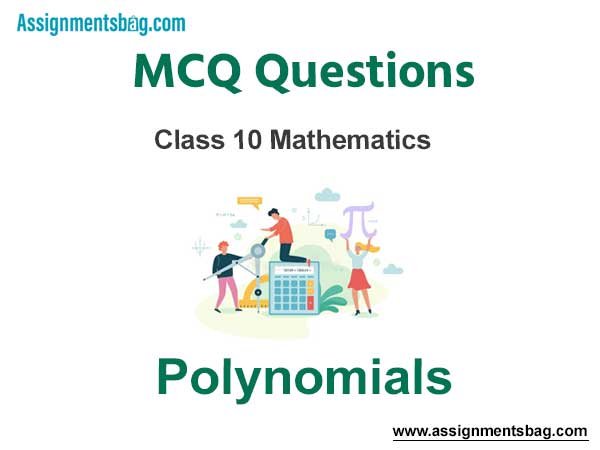Please refer to MCQ Questions Chapter 2 Polynomials Class 10 Mathematics with answers provided below. These multiple-choice questions have been developed based on the latest NCERT book for class 10 Mathematics issued for the current academic year. We have provided MCQ Questions for Class 10 Mathematics for all chapters on our website. Students should learn the objective based questions for Chapter 2 Polynomials in Class 10 Mathematics provided below to get more marks in exams.
Chapter 2 Polynomials MCQ Questions
Please refer to the following Chapter 2 Polynomials MCQ Questions Class 10 Mathematics with solutions for all important topics in the chapter.
MCQ Questions Answers for Chapter 2 Polynomials Class 10 Mathematics
Question. If α ≠ β and the difference between the roots of the polynomials x2 + ax + b and x2 + bx + a is the same, then
(a) a + b + 4 = 0
(b) a + b − 4 = 0
(c) a − b + 4 = 0
(d) a − b − 4 = 0
Answer
A
Question. The value of ‘a’, for which one root of the quadratic polynomial (a2 −5a + 3) x2 + (3a − 1) x + 2 is twice as large as the other, is
(a) − 1/ 3
(b) 2 /3
(c) − 2 /3
(d) 1/ 3
Answer
B
Question. If α ≠ β and α2 = 5α − 3, β2 = 5β − 3, then the polynomial whose zeros are α/β and β/α is :
(a) 3x2 − 25x + 3
(b) x2 − 5x + 3
(c) x2 + 5x − 3
(d) 3x2 − 19x + 3
Answer
D
Question. The homogeneous function of the second degree in x and y having 2x − y as a factor, taking the value 2 when x = y = 1 and vanishing if x = −1, y = 1 is
(a) 2x2 + xy − y2
(b) 3x2 − 2xy + y2
(c) x2 + xy − 2y2
(d) None of these
Answer
A
Question. The common quantity that must be added to each term of a2 : b2 to make it equal to a : b is
(a) ab
(b) a + b
(c) a − b
(d) a/ b
Answer
A
Question. The factors of a2(b3 − c3) + b2(c3 − a3) + c2(a3 − b3)are
(a) (a − b) (b − c) (c − a) (ab + bc + ca)
(b) (a + b) (b + c) (c + a) (ab + bc + ca)
(c) (a − b) (b − c) (c − a) (ab − bc − ca)
(d) None of these
Answer
A
Question. If p,q are zeros of x2 + px + q, then
(a) p = 1
(b) p = 1 or 0
(c) p = − 2
(d) p = − 2 or 0
Answer
A
Question. On simplifying (a + b)3 + (a − b)3 + 6a(a2 − b2) we get
(a) 8a2
(b) 8a2b
(c) 8a3b
(d) 8a3
Answer
D
Question. Factors of (42 − x − x2) are
(a) (x − 7)(x − 6)
(b) (x + 7)(x − 6)
(c) (x + 7)(6 − x)
(d) (x + 7)(x + 6)
Answer
C
Question. If a − b = 3, a + b + x = 2, then the value of (a − b)[x3 − 2ax2 + a2x − (a + b)b2] is
(a) 84
(b) 48
(c) 32
(d) 36
Answer
B
Question. If abx2 = (a − b)2(x + 1), then the value of 1 + 4/x + 4 x2 is:-
(a) (a − b/a +b)2
(b) (a+b/a −b)2
(c) (a/a+b)2
(d) (b/a+b)2
Answer
B
Question. Let a,b be the zeros of the polynomial (x − a) (x − b) − c with c ≠ 0. Then the zeros of the polyno- mial (x − α) (x − β) + c are
(a) a, c
(b) b, c
(c) a, b
(d) a + c, b + c
Answer
C
Question. Factors of (x2 +x/6 −1/6) are
(a) 1/ 6 (2x+1)(3x+1)
(b) 1/ 6 (2x+1)(3x−1)
(c) 1/ 6 (2x−1)(3x−1)
(d) 1/ 6 (2x−1)(3x+1)
Answer
B
Question. If the polynomial x19 + x17 + x13 + x11 + x7 + x5 + x3 is divided by (x2 + 1), then the remainder is
(a) 1
(b) x2 + 4
(c) −x
(d) x
Answer
C
Question. If (x − 2) is a common factor of x3 − 4x2 + ax + b and x3 − ax2 + bx + 8, then the values of a and b are respectively
(a) 3 and 5
(b) 2 and −4
(c) 4 and 0
(d) 0 and 4
Answer
D
Question. In method of factorization of an algebraic expression, Which of the following statements is false?
(a) Taking out a common factor from two or more terms
(b) Taking out a common factor from a group of terms
(c) By using remainder theorem
(d) By using standard identities
Answer
C
Question. Factors of (a + b)3 − (a − b)3 are
(a) 2ab(3a2 + b2)
(b) ab(3a2 + b2)
(c) 2b(3a2 + b2)
(d) 3a2 + b20
Answer
C
Question. Value of x3 +b3 +c3 −3abc/ab +bc + ca −c2 −b2 −c2 , when a = −5, b = −6, c = 10 is
(a) 1
(b) −1
(c) 2
(d) −2
Answer
A
Question. If (x + y + z) = 1, xy + yz + zx = −1, xyz = −1, then the value of x3 + y3 + z3 is
(a) −1
(b) 1
(c) 2
(d) −2
Answer
B
Question. If the polynomial 16×4 − 24x3 + 41x2 − mx + 16 be a perfect square,then the value of “m” is
(a) 12
(b) −12
(c) 24
(d) −24
Answer
C
Question. The square root of x2/y2 + y2/4x2 −x/y +y/2x −3/4 is
(a) x/y −1/2 −y/2x
(b) x/y +1/2 −y/2x
(c) x/y +1/2 +y/2x
(d) x/y −1/4 −y/2x
Answer
A
Question. If (3 + √3) is one of the zeroes of the quadratic polynomial x2 + mx + 6 then find the second zero.
(a) -√3
(b) 3 – √3
(c) 3 + √3
(d) √3
(e) None of these
Answer
B
Question. If m = a + 1 /a – 1 and n = a – 1/a + 1 , then m2 + n2 – 3 mn, is equal to

Answer
A
Question. For a quadratic polynomial 2x2 – 8x + b , sum of its roots is 4 and one of the roots is 4 +√2/2 , then the value of b is_____
(a) 3
(b) 6
(c) 7
(d) 8
(e) None of these
Answer
C
Question. If the zeroes of the quadratic polynomial p(x) = ax2 – (b2 – ac) x – bc are α & β , then
(a) α= -b2/a and α = -c2/b
(b) α = a/b and β = b/c
(c) α = b/a and β = -c/b
(d) α = -a/b and β = c/b
(e) None of these
Answer
C
Question. If α and α are zeroes of the quadratic polynomial p(x) = ax2 – bx + c , then the value of α/β + β/α is .
(a) b2 + ac/ac
(b) b2 – ac/ac
(c) b2 + 2ac/ac
(d) c2 + 2ac/ac
(e) None of these
Answer
B
Question. If the zeroes of the quadratic polynomial ax2 – x – b are -3/1 and 5/3 , then
(a) a = 15, b = 6
(b) a = 6, b = 15
(c) a = 12, b = 4
(d) a = 4, b = 12
(e) None of these
Answer
B
Question. If p(x) = 25x2 – 15x – a where α and β are the zeroes of the polynomial, also if it is given that α3 + β3 = 63/125 , then
(a) a = 5
(b) roots are -1/5 and 4/5
(c) a = 3
(d) roots are 1/5 and -2/5
(e) None of these
Answer
B
Question. Which one among the following statements is incorrect?
(a) Graph of a linear polynomial is a straight line whereas the graph of a quadratic polynomial has one of the two shapes of parabola either open upwards ∪ or open downwards ∩.
(b) The shape of the parabola depends on the value of ‘a’ of the quadratic polynomial ax2 + bx + c .
(c) The zeroes of a quadratic polynomial ax2 + bx +c , a ≠ 0 are y coordinates of the points where the parabola y= ax2 + bx + c intersects the y-axis.
(d) A real number m is a zero of the polynomial p(x) if p (m) = 0
(e) None of these
Answer
C
Question. If all the zeroes of the cubic polynomia x3 + cx2 + dx + b are equal, then
(a) cd = 9 b
(b) bd = 8 b
(c) cd = 6 b
(d) bd = 8 b
(e) None of these
Answer
A
Question. If the LCM of p(x) and q(x) is a9 – b9 then their HCF can be
(a) (a – b)
(b) (a2 + b2 + ab)
(c) a6 + b6 + a3 b3
(d) All the above
(e) None of these
Answer
D
Question. If (x − 3) is the factor of 3x3 − x2 + px + q then___
(a) p + q = 72
(b) 3p + q = 72
(c) 3p + q = −72
(d) q − 3p = 72
Answer
C
Question. For what values of n, (x + y) is a factor of (x − y)n.
(a) for all values of n
(b) 1
(c) only for odd numbers
(d) none of these
Answer
D
Question. If the zeros of the polynomial ax2 + bx + c be in the ratio m : n, then
(a) b2 mn = (m2 + n2) ac
(b) (m + n)2 ac = b2 mn
(c) b2 (m2 + n2) = mnac
(d) None of these
Answer
B
Question. A homogeneous expression of second degree in x & y is
(a) ax2 + bx + c
(b) ax2 + bx + cy
(c) ax2 + bx + cy2
(d) ax2 + bxy + cy2
Answer
D
Question. If the sum of the zeros of the polynomial x2 + px + q is equal to the sum of their squares, then
(a) p2 − q2 = 0
(b) p2 + q2 = 2q
(c) p2 + p = 2q
(d) None of these
Answer
C
Question. The G.C.D of x2 − 3x + 2 and x2 − 4x + 4 is
(a) x − 2
(b) (x − 2)(x − 1)
(c) (x − 2)2
(d) (x − 2)3(x − 1)
Answer
A
Question. If h(x) = 2x3 + (6a2 − 10) x2 + (6a + 2) x − 14a − 2 is exactly divisible by x − 1 but not by x + 1, then the value of a is
(a) 0
(b) −1
(c) 10
(d) 2
Answer
D
Question. Given the polynomial is exactly divided by x + 1, and when it is divided by 3x − 1, the remainder is 4. The polynomial gives a remainder hx + k when divided by 3×2 + 2x − 1 then the values of h and k are
(a) h = 2, k = 3
(b) h = 3, k = 3
(c) h = 3, k = 2
(d) None of these
Answer
B
Question. The G.C.D. of two polynomials is (x − 1) and their L.C.M. is x6 − 1. If one of the polynomials is x3 − 1, then the other polynomial is_____.
(a) x3 − 1
(b) x4 − x3 + x − 1
(c) x2 − x + 1
(d) None of these
Answer
B
Question. The L.C.M. of 2x and 8 is
(a) 2x
(b) 4x
(c) 8x
(d) 16x
Answer
C
Question. If x2 + 1/ x2 = 38, then the value of x − 1/ x is
(a) 6
(b) 4
(c) 0
(d) None
Answer
A
Question. The simplest form of (2x + 3)3 − (2x − 3)3 is
(a) 54 + 72x2
(b) 72 + 54x2
(c) 54 + 54x2
(d) None of these
Answer
A
Question. The simplest form of (p − q)3 + (q − r)3 + (r − p)3 is
(a) 4(p − q)(q − r)(r − p)
(b) 2 (p − q)(q − r)(r − p)
(c) (p − q)(q − r)(r − p)
(d) None of these
Answer
C
Question. The square root of x4 + 6x3 + 17x2 + 24x + 16 is
(a) x2 + 3x + 4
(b) 2x2 + 3x + 4
(c) 3x2 + 3x + 4
(d) None of these
Answer
A
Question. The square root of x4 − 2x3 + 3x2 − 2x + 1 is
(a) x2 + x + 1
(b) x2 − x + 1
(c) x2 + x − 1
(d) x2 − x − 1
Answer
B
Question. If x + 1/ x = 5, then the value of x3 + 1/x3 is
(a) 110
(b) 90
(c) 80
(d) 50
Answer
A
Question. If x3 −(x + 1)2 = 2001 then the value of x is
(a) 14
(b) 13
(c) 10
(d) None
Answer
B
Question. The value of l for which one zero of 3x2 − (1 + 4λ) x + λ2 + 2 may be one-third of the other is
(a) 4
(b) 33/ 8
(c) 17/ 4
(d) 31/ 8
Answer
D
Question. The factors of a3(b − c) + b3(c − a) + c3(a − b) are
(a) (a + b + c) (a − b) (b − c) (c − a)
(b) − (a + b + c) (a − b) (b − c) (c − a)
(c) 2 (a + b + c) (a − b) (b − c) (c − a)
(d) − 2 (a + b + c) (a − b) (b − c) (c − a)
Answer
B
Question. If the expressions ax3 + 3x2 − 3 and 2x3− 5x + a on dividing by x − 4 leave the same remainder, then the value of a is
(a) 1
(b) 0
(c) 2
(d) −1
Answer
A
Question. If the polynomial x6 + px5 + qx4 − x2 − x − 3 is divisible by x4 − 1, then the value of p2 + q2 is
(a) 1
(b) 5
(c) 10
(d) 13
Answer
C
Question. The value of m if 2xm + x3 − 3x2 − 26 leaves a remainder of 226 when it is divided by x − 2.
(a) 0
(b) 7
(c) 10
(d) All of these
Answer
B
Question. The expression Ax3 + x2 + Bx + C leaves remainder of 21 4 when divided by 1 − 2x and 18 when divided by x. Given also the expression has a factor of (x − 2), the values of A, B and C are
(a) A = 5, B = − 9, C = 3
(b) A = 27, B = − 18, C = 4
(c) A = 4, B = − 27, C = 18
(d) None of these
Answer
C
Question. The remainder when f(x) = (x4 − x3 + 2x − 3) g(x) is divided by x − 3, given that x − 3 is a factor of g(x) + 3, where g(x) is a polynomial is
(a) 0
(b) −171
(c) 10
(d) 2
Answer
B
Question. If x3 − hx2 + kx − 9 has a factor of x2 + 3, then the values of h and k are
(a) h = 3, k = 3
(b) h = 2, k = 2
(c) h = 2, k = 1
(d) None of these
Answer
A
Question. The L.C.M. of 22x(x + 1)2 and 36x2(2x2 + 3x + 1) is
(a) 2x(x + 1)
(b) 396x2(x + 1)2(2x + 1)
(c) 792x3(x + 1)2 (2x2 + 3x + 1)
(d) None of these
Answer
B
Question. If 3x3 + 2x2 − 3x + 4 = (Ax + B)(x − 1)(x + 2) + C(x − 1) + D for all values of x, then A + B + C + D is
(a) 0
(b) 14
(c) 10
(d) All
Answer
B
Question. The expression x3 + gx2 + hx + k is divisible by both x and x − 2 but leaves a remainder of 24 when divided by x + 2 then the values of g, h and k are
(a) g = 10, h = − 3, k = 0
(b) g = 3, h = − 10, k = 0
(c) g = 10, h = − 2, k = 3
(d) None of these
Answer
B
Question. The L.C.M of x3 − 8 and x2 − 5x + 6 is
(a) x − 2
(b) x2 + 2x + 4
(c) (x − 2)(x2 + 2x + 4)
(d) (x −2)(x − 3)(x2 + 2x + 4)
Answer
D
Question. The polynomial f(x) has roots of equations 3, −3, −k. Given that the coefficient of x3 is 2, and that f(x) has a remainder of 8 when divided by x + 1, the value of k is
(a) 1/2
(b) 1/4
(c) 1/5
(d) 2
Answer
A
Question. The cubic polynomials whose zeros are 4, 3/ 2 and −2 is :
(a) 2x3 + 7x2 + 10x − 24
(b) 2x3 + 7x2 − 10x − 24
(c) 2x3 − 7x2 − 10x + 24
(d) None of these
Answer
C
Question. One of the factors of x3 + 3x2 − x − 3 is
(a) x + 1
(b) x + 2
(c) x − 2
(d) x − 3
Answer
A
Question. If ax2 + 2a2x + b3 is divisible by x + a, then _____.
(a) a = b
(b) a + b = 0
(c) a2 − ab + b2 = 0
(d) a2 + 2ab + b2 = 0
Answer
A
Question. If x3 + 2x2 + ax + b is exactly divisible by (x + a) and (x − 1), then _____.
(a) a = −2
(b) b = −1
(c) a = −1
(d) b = 1
Answer
C
Question. The quadratic polynomial whose sum and product of zeroes is 7 and –5 is:
(a) x2 – 7x + 5
(b) x2 + 7x – 5
(c) x2 – 7x – 5
(d) none of these
Answer
C
Question. If α,β are the zeroes of f(x) = x2 + x + 1, then 1/ α + 1/ β is :
(a) 0
(b) 1
(c) –1
(d) none of these
Answer
C
Question. The cubic equation with zeroes 2, 3 and 4 is :
(a) x3 – 9x2 + 26 x– 24
(b) x3 + 9x2 – 26x – 24
(c) x3 – 9x2 – 26x + 24
(d) none of these
Answer
A
Question. The value of p(x) = x3 – 6x2 + 11x – 6 at x = 3 is :
(a) –38
(b) 0
(c) 12
(d) none of these
Answer
B
Question. The quotient when f(x) = x3 – 6x2 + 11x – 6 is divided by x + 2 is :
(a) x2 + 8x – 27
(b) x2 – 8x + 27
(c) x2 – 8x – 27
(d) none of these
Answer
B
Question. The graph of y = x2 – 2x– 8 cuts the x-axis at:
(a) –2 and 4
(b) 2 and –4
(c) do not cut
(d) none of these
Answer
A
Question. The sum of squares of zeroes of f(x) = x2 – 8x + k is 40. the value of k is
(a) –12
(b) 12
(c) 24
(d) none of these
Answer
B
Very Short Answer and Question :
Question. What should be subtracted from the polynomial x2 – 7x –12 so that x = –4 is a zero of the polynomial ?
Answer
56
Question. Write a polynomial whose zeroes are –3 and 2/ 3 .
Answer
3x2 + 7x − 6
Question. How many zeroes does the polynomial p(x) – x(x – 2)(x – 3) have in all ?
Answer
3
Question. How many maximum number of zeroes a quadratic polynomial can have ?
Answer
2
Question. Give an example of polynomials p(x), g(x), q(x) and r(x), which satisfy the division algorithm and deg r(x) = 0.
Answer
p(x) = x2 + 5x + 7, g(x) = x + 2, q(x) = x + 3, r(x) = 1
Question. Find a quadratic polynomial whose two roots are 3 – √5 and 3 +√5 .
Answer
x2 – 6x + 4
Question. Write the sum and the product of the zeroes of the polynomial 3x2 – 5x + 9. sum = 5 /3 , product =
Answer
3
Question. What is the value of ‘p’ in the polynomial f (x) – x2 –11x – p if –4 is a zero of the polynomial ?
Answer
28
Question. Find a cubic polynomial whose three zeroes are 0, 3, –3.
Answer
x3 – 9x

We hope you liked the above provided MCQ Questions Chapter 2 Polynomials Class 10 Mathematics with solutions. If you have any questions please ask us in the comments box below.


